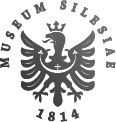The Historical Exhibition Building is one of the six exhibition premises of the Silesian Museum. It is a standalone Neo-Renaissance building, built to house the Emperor Franz Joseph Museum of Art and Crafts, founded in Opava in 1882 on the initiative of the Chamber of Commerce and Crafts, which also financed the building of the structure. The museum is built on land donated by the Prince von Liechtenstein.
The building was constructed according to a nearly square-shaped design by the Viennese architects Johann Scheiringer and Franz Kachler between 1893-95. The Genius and Pegasus statues decorating the cupola were created by the Viennese sculptor Theodor Friedel. The side facade faces Komenského street and the richly decorated frontal facade faces the municipal park. The statues decorating the frontal facade, allegorical figures representing Painting, Sculpture and Architecture, are the work of the Viennese sculptor Karl Schwerzek.
This monumental, Neo-Renaissance building was seriously damaged in air raids in the spring of 1945. The subsequent renovation process took ten years and resulted in a more modern interior design, while respecting the facade and original layout of the museum.
The year 1955 saw the opening of the first post-war exhibition in the reconstructed museum. This exhibition documented the then-current trend to give the presentation of the history of Silesia a contemporary slant. The form and concept of the second post-war exhibition, which opened in 1981, was also influenced by ideology. Called The Development of Nature and Society in the North Moravia Region, it addressed scientific, as well as social, issues. These themes were presented in separate sections of the exhibition, determined by the configuration of the building. In 1985 the Historical Exhibition Building was declared a national heritage building.
Relatively soon after the exhibition opened to the public, the building was closed due to the engineering challenge of building a cupola in an urban area. Following the completion of the cupola, part of the former Liechtenstein Hall (i.e. the area that opened into the cupola) was refitted. Further alterations were also made to the park-facing side, where the cabin of a Tatra lorry was put on display and an educational centre was constructed. However, this part of the museum, as well as those connected to it, was removed soon afterwards – soon after the Velvet Revolution in November 1989.
Post-Velvet Revolution changes affected the opposite part of the first floor, too, where the passageway between the exhibition halls, formed through the installation of a linking bridge across the side stairwell, was closed off. These changes were necessitated by, amongst other things, the need to repair the roof due to the leakage of rainwater into the structure. This led to the removal of the permanent archaeology and history exhibitions. The ground floor of the building repeatedly suffered from technical problems.
This brief description of the structure shows that it was in a parlous state long before 2010. Apart from structural problems, the exhibition itself suffered from short-termism and lack of a clear vision, with issues being dealt with on a case-by-case basis (e.g. the ‘Opava’ section of the From Gothic to Modern (1999) became an unplanned ‘permanent exhibition’, which was not removed until just before the start of refurbishment work in 2010). The necessity for a complex solution for the Historical Exhibition Building was, therefore, a result of the physical condition of the building, operational and technical shortcomings and the long-term absence of the conceptual use of the building for exhibitions to reflect current state of research into the history and culture of Czech Silesia, together with a knowledge of current trends in museum presentation, while respecting the experience of previous generations of Silesian Museum employees.
The refurbished building, with its new exhibition Silesia, opened to the public in May 2012.
Article last updated: 10.06.2013
Print whole article



